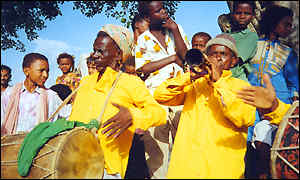 In old times, some East Africans came to India through the slave trade.There is, however, no evidence of great numbers of African slaves in India. Africans also visited India as free people - as merchants and ambassadors from East African states.1 Africans are called Habshi or Habashi in India. Habashi is the Arabic word for "Ethiopian". Numerous Habshis achieved political and military success in South Asia.2
In old times, some East Africans came to India through the slave trade.There is, however, no evidence of great numbers of African slaves in India. Africans also visited India as free people - as merchants and ambassadors from East African states.1 Africans are called Habshi or Habashi in India. Habashi is the Arabic word for "Ethiopian". Numerous Habshis achieved political and military success in South Asia.2A group of African freedmen converted to Islam and became known as the Siddis. The Siddis were sailors and established kingdoms in Western India as early as 1100 AD. They functioned as security forces for the Muslim fleets in West India and were famed for their bravery as "guarantors of safety on the Indian Ocean" (in the words of Ibn Battuta). Their commanders were titled Admirals of the Mogul Empire and received an annual salary of 300,000 rupees.3 The Siddis were active up to the end of the 19th century.
In the 16th century, there were many powerful Habshis in the political scene of India. Indian states employed foreign slaves as military officers and government administrators. Chingiz Khan, the prime minister to Nizam mul-Mulk Bani, King of Ahmadnagar in 1575, was of African origin. After the king's death, the king's son Murtaza I led a successful revolt with several Habshis against his mother's claim to power. 4 In 1595, during the reign of Murtaza II, the prime minister Abhangar Khan was also a Habshi.5
During the same period, Ambar, an Ethiopian slave, commanded Arab troops for the king of Bijapur6. In 1590, Ambar broke away from Bijapur and built an independent mercenary army of over 1500 African, Arab and local Dakani men. He eventually joined the state of Ahmadnagar and later imprisoned King Murtaza II, naming himself regent minister. Ambar promoted minorities of various ethnic groups to key positions and implemented financial, educational and agricultural reforms.7 Ferista, an contemporary Arab historian, praised Ambar: "he appears to have been the most enlightened financier of whom we read in Indian history." Ambar also organized a 60,000 horse army and successfully beat back the Moguls for the next 20 years. The Moguls could not conquer Dakan until after his death.8
Many Habshi officers were prominent in the Muslim courts of Dakan and the Mogul empire in the 17th century. Today, the Habshi communities have been diminished due to widespread intermarriage with other Muslims.9
Africans also found a place among the Baluchis, a large Indo-Iranian ethnic group living in Pakistan, Iran, Afghanistan and the Arab Emirates. Baluchi ethnicity is defined more by language than by 'race', which made it easy for them to absorb people from other ethnic groups, including expatriate Africans. The Baluchis practice a number of different trance rituals, one type of which (the guati)involves spirits of African origin, and is performed to music with African rhythmic structures. Some of the melodies used for the rituals were composed by Baluchi musicians of African origin.10
Source: http://www.colorq.org/MeltingPot/article.aspx?d=Asia&x=Habshi
No comments:
Post a Comment